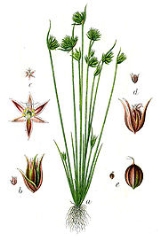
Juncus capitatus
Encyclopedia
Juncus capitatus is a species of rush
known by the common name leafybract dwarf rush. It is native to Eurasia and North Africa. It is also an introduced species
in parts of North America such as California
and the Gulf Coast
. It grows in moist areas, such as wet sand, vernal pool
s, and ditches. This is a small annual herb not exceeding ten centimeters in height. The stems are erect and thready, flat or somewhat corrugated. The leaves are basal and up to 3 or 4 centimeters long. The plant is green to red or brownish in color. Each stem bears an inflorescence
of up to six clustered flowers. The pointed bract
s at the base of the inflorescence are often over a centimeter long, longer the flower cluster itself, and are somewhat leaflike, giving the species its common name. Each flower has pointed outer tepal
s and thinner, shorter, oval-shaped inner tepals. There are three stamen
s. The fruit is a tiny oval-shaped capsule one to two millimeters long.
Juncus
Juncus is a genus in the plant family Juncaceae. It consists of some 200 to 300 or more species of grassy plants commonly called rushes...
known by the common name leafybract dwarf rush. It is native to Eurasia and North Africa. It is also an introduced species
Introduced species
An introduced species — or neozoon, alien, exotic, non-indigenous, or non-native species, or simply an introduction, is a species living outside its indigenous or native distributional range, and has arrived in an ecosystem or plant community by human activity, either deliberate or accidental...
in parts of North America such as California
California
California is a state located on the West Coast of the United States. It is by far the most populous U.S. state, and the third-largest by land area...
and the Gulf Coast
Gulf Coast of the United States
The Gulf Coast of the United States, sometimes referred to as the Gulf South, South Coast, or 3rd Coast, comprises the coasts of American states that are on the Gulf of Mexico, which includes Texas, Louisiana, Mississippi, Alabama, and Florida and are known as the Gulf States...
. It grows in moist areas, such as wet sand, vernal pool
Vernal pool
Vernal pools, also called vernal ponds or ephemeral pools, are temporary pools of water. They are usually devoid of fish, and thus allow the safe development of natal amphibian and insect species...
s, and ditches. This is a small annual herb not exceeding ten centimeters in height. The stems are erect and thready, flat or somewhat corrugated. The leaves are basal and up to 3 or 4 centimeters long. The plant is green to red or brownish in color. Each stem bears an inflorescence
Inflorescence
An inflorescence is a group or cluster of flowers arranged on a stem that is composed of a main branch or a complicated arrangement of branches. Strictly, it is the part of the shoot of seed plants where flowers are formed and which is accordingly modified...
of up to six clustered flowers. The pointed bract
Bract
In botany, a bract is a modified or specialized leaf, especially one associated with a reproductive structure such as a flower, inflorescence axis, or cone scale. Bracts are often different from foliage leaves. They may be smaller, larger, or of a different color, shape, or texture...
s at the base of the inflorescence are often over a centimeter long, longer the flower cluster itself, and are somewhat leaflike, giving the species its common name. Each flower has pointed outer tepal
Tepal
Tepals are elements of the perianth, or outer part of a flower, which include the petals or sepals. The term tepal is more often applied specifically when all segments of the perianth are of similar shape and color, or undifferentiated, which is called perigone...
s and thinner, shorter, oval-shaped inner tepals. There are three stamen
Stamen
The stamen is the pollen producing reproductive organ of a flower...
s. The fruit is a tiny oval-shaped capsule one to two millimeters long.

